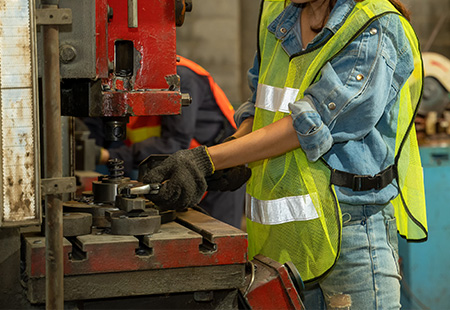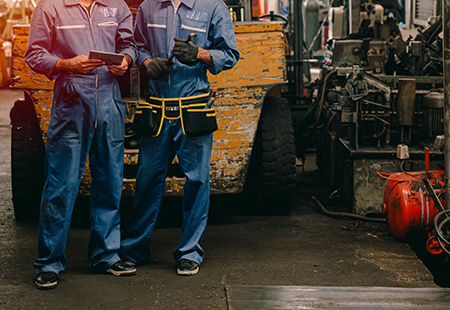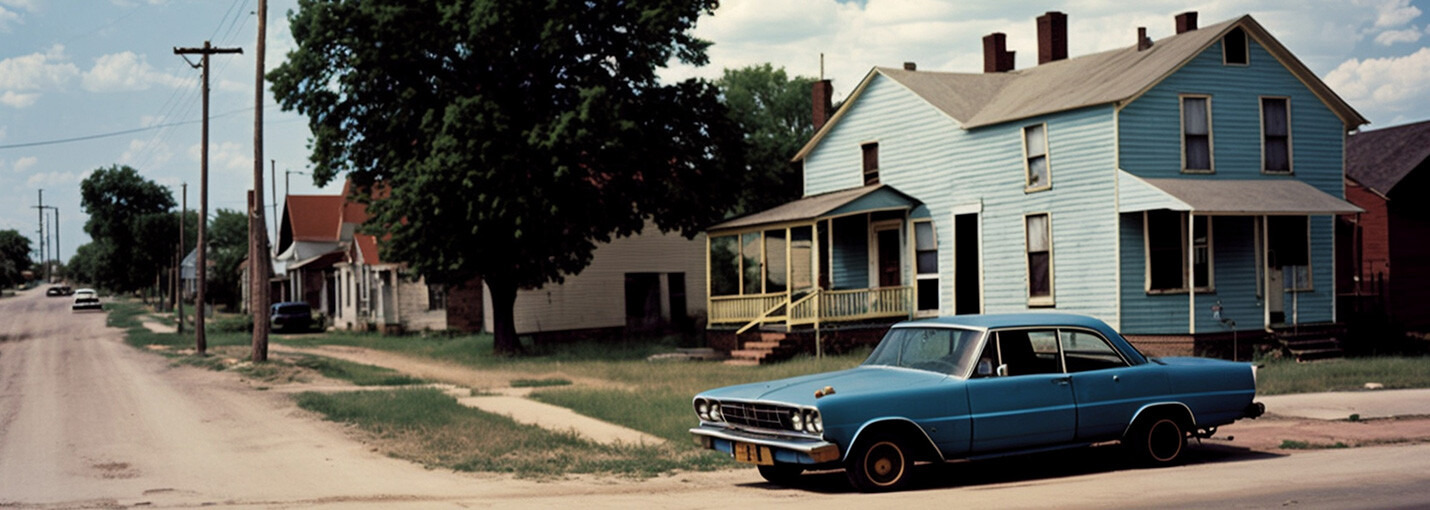Do homes built in 1910 have asbestos?
| Quite possibly. Nearly every building constructed before the mid-1980s contained asbestos products of some kind, often more than one. Property owners and people living or working in old buildings should take caution and have the property tested where necessary. If asbestos needs to be removed from your older home, use a professional. |
Use caution with an older home built in the twentieth century; most contained some type of asbestos.
!
If you believe that you were exposed to asbestos, even as a child, speak to a healthcare provider about tests and screening to help diagnose lung-scarring and screen for asbestos-related diseases.
Understanding the dangers of asbestos products built into older homes and buildings.
Asbestos was once widely used in the manufacture of construction material and popular consumer products.
 |
| Nearly every building constructed before the mid-1980s contained asbestos products and building materials. |
 |
What exactly is asbestos?
A type of naturally-occurring mineral, its inherent resilience to fire, electricity, and corrosion lent it near-unprecedented industrial potential. It was used to fireproof tenements, insulate electrical consoles, and even reinforce military equipment. Asbestos production in the United States soared in the post-World War II period, peaking in the 1970s before falling into disarray amidst strict regulation and—eventually—outright prohibition.
| Asbestos is highly resistant to heat, pressure and corrosion, so it was used in many products, vehicles and buildings. In particular, many workplaces like factories, refineries, foundries and shipyards involve high amounts of heat, and were built with a lot of asbestos. | |||
 |  |  |  |
The federal government has long since limited the authorized uses of this so-called “miracle mineral.” However, the asbestos industry was never ordered to recall its products or abate unsafe properties. According to some reports, an estimated 30 million American homes still contain potentially life-threatening concentrations of asbestos.
While the American asbestos industry was still in its infancy in the early 20th century, a home built in 1910 is still at high risk for asbestos contamination.
Asbestos has no taste or smell.
You may not know you’re breathing it.

Asbestos in Early 20th Century Homes
In Europe, asbestos had a longstanding reputation as a mineral with near-magical properties. However, before the advent of the Industrial Revolution, asbestos’s applications seemed limited to the creation of novelty products, including fireproof tablecloths and heat-resistant overcoats.
During the Industrial Revolution, factories across Europe found themselves in sudden need of inexpensive insulating materials. Asbestos deposits were aggressively identified and mined, with bonded fibers used to fabricate heat-resistant machinery, pipes, and boiler ducts.
Asbestos production in the United States was, in contrast, somewhat delayed. It was used in home construction before 1914, and employed to insulate submarines and other warships during the First World War.
“The overall evidence suggests there is no safe level of asbestos exposure.”Source: National Cancer Institute (NIH)1 |
Would a home built in 1910 have asbestos?
Possibly, and quite likely if it hasn’t been renovated extensively. A home that was built in 1910 could contain asbestos-containing materials including, but not limited to, the following:
• Any vermiculite-containing product, especially insulation
• Asphalt flooring
• Cinder blocks
• Electrical units and consoles
• Furnaces
• Roofing components
• Roof shingles, especially cement roof shingles
• Stucco
• Thermal system insulation
Although the range of available asbestos products in 1910 was not as extensive as in later decades, most homes built in the early 20th century are likely to have undergone significant renovations.
“All forms of asbestos are carcinogenic to humans.” 2
Renovations and demolition can release harmful asbestos fibers into the air.
If any renovations were conducted in later years, original construction materials—including construction materials that may have been asbestos-free—could have been replaced with asbestos-containing products.
“Some asbestos fibers may bypass…your body’s natural defenses…and lodge deep within your lungs. Those fibers can remain in place for a very long time and may never be removed.”Source: American Lung Association |
How to Remove Asbestos Safely
Asbestos removal should always be performed by an experienced and certified professional.
Almost every state maintains a register of companies and individuals licensed to remove, and dispose of, asbestos-containing materials.
While every property warrants its own removal strategy, asbestos abatement professionals typically employ either, or both of, the following methods:
Encapsulation
Encapsulation is a cost-effective alternative to removal. During encapsulation, the abatement company will usually cover the suspected asbestos-containing materials in a special sealant. This sealant “encapsulates” both the product and any degraded asbestos fibers within an adhesive matrix.
Removal
In heavily-contaminated homes, encapsulation is not always practicable or advisable.
While removing asbestos can be time-consuming, it is the only surefire way to eliminate the risk of exposure from a property.
Asbestos removal procedures vary, but they usually involve the following steps:
| 1. The asbestos-contaminated area is sealed off from the rest of the home using plastic sheeting and other materials. |
| 2. High-powered air filters are placed inside of the asbestos-contaminated area, and exhaust ducts are placed outside. |
| 3. The work area is secured, and abatement begins. Homeowners, visitors, and other non-authorized persons may not be allowed inside the asbestos-contaminated area until abatement has concluded. |
| 4. While working inside of the asbestos-affected area, abatement professionals will wear tight-fitting masks or respirators. They may also wear disposable work clothing and install portable showers to ensure that fiber is not tracked inside or across the property. |
| 5. Some companies perform in-progress air inspections to ensure that environmental asbestos levels remain stable. |
| 6. After abatement is complete, any removed asbestos-containing materials are placed inside of sealed containers and transported to authorized asbestos landfills or asbestos recycling centers. |

Asbestos Abatement: Is Asbestos Removal or Encapsulation Worth the Cost?
Identifying asbestos can be difficult, even for trained professionals. However, most homeowners should presume that asbestos is present in any structure built before or during the 1980s.
Despite its longstanding reputation as a “miracle mineral,” asbestos is today categorized as a human carcinogen. Exposure to asbestos, especially aerosolized asbestos, can cause significant respiratory distress and is associated with illnesses including asbestosis, pleural disease, and cancer.
The health risks of asbestos exposure can include:
| Mesothelioma: cancer of the mesothelium, the thin layer of tissue surrounding the body’s organs. This cancer is only known to be caused by asbestos exposure. | Lung cancer |
| Laryngeal cancer: cancer of the larynx (section of the throat called the voicebox) | Ovarian cancer |
| Stomach cancer | Colon cancer |
| Pharyngeal cancer | Asbestosis: a chronic lung disease associated with asbestos exposure |
| Chronic Obstructive Pulmonary Disease (COPD) | Atelectasis (collapsed lung) |
| Pleural effusion (collection of fluid around the lungs) | Pericardial effusion (collection of fluid around the heart) |
Asbestos is most dangerous when it becomes airborne (friable asbestos).
Damaged buildings, or those undergoing renovation or demolition can release asbestos fibers.
While asbestos is anything but safe, homeowners do not necessarily have to worry about the presence of historical asbestos-containing materials. If and when asbestos is kept in a safe, inaccessible location, it does not necessarily pose any risk to human health and well-being.
Unfortunately, otherwise-stable asbestos products can crumble, or become friable, during the course of routine home renovations. Asbestos is at its most dangerous when it is friable, because friable asbestos can easily scatter into the air, where it could be inhaled.
“Generally, those who develop asbestos-related diseases show no signs of illness for a long time after exposure.”Source: National Cancer Institute (NIH)3 |
If you believe that your home built in or around 1910 could contain asbestos, you should consider abatement if any of the following circumstances exist:
• You have received a positive result from an asbestos test.
The presence of asbestos in a home is almost always a reason for concern. However, positively identifying asbestos is not easy and may require testing.
Private companies and many public health agencies typically offer asbestos air tests; some also provide self-test kits, which can be used to collect samples from suspected asbestos-containing materials. If the sample is confirmed to be asbestos, homeowners may need to consider asbestos abatement depending on the location and extent of the contamination.
Do You Qualify For Compensation?
Quickly and easily find out how you were exposed by searching W.A.R.D., the largest asbestos database on the planet.
FREE SEARCH >• You have friable asbestos-containing materials in an easily-accessible space.
Asbestos, even friable asbestos, is not dangerous unless and until it is disturbed. Some asbestos-containing materials do not have to be immediately removed, provided that such asbestos-containing materials are stable, inaccessible, and unlikely to come into contact with people.
Conversely, asbestos that is easily accessible may need to be abated, especially if it has started to crumble. Easily accessible asbestos could include asbestos-based products that are friable and at risk of being dispersed throughout a property via a furnace or other climate control system.
• You are planning to sell your home.
Every state has its own laws regulating and detailing liability for asbestos-related illnesses. In many states, a homeowner could be found liable for asbestos-related injuries if they knew that their property contained asbestos but failed to inform the purchaser.
AsbestosClaims.Law
At AsbestosClaims.Law, our mission to secure compensation for asbestos victims is more than professional; it’s personal.
Our founder, Justinian C. Lane, understands the devastating impacts of asbestos firsthand.
Both his grandparents and father, all asbestos workers, passed away from asbestos-induced cancers without realizing their eligibility for asbestos lawsuits or other forms of compensation.
We aim to prevent such tragic oversights by informing and guiding victims and their families through their legal options.
If you or your loved ones have suffered as a result of asbestos exposure, you could be eligible for considerable compensation. These funds could provide for medical treatments, asbestos removal services, and safeguard your health.
In addition, asbestos trusts offer compensation without the need for a lawsuit, providing a quicker, simpler path to justice.
Reach out to us at [email protected] or (206) 455-9190 for assistance with your claim. We offer compassionate listening, clear explanations, and we don’t charge a dime unless we win your case.
Beyond legal claims, we also advise on veterans’ disability, social security, and employment protection like workers’ compensation, FELA, and The Jones Act for maritime workers.
There’s no risk or cost to connect with our experienced team about your rights. Our commitment to your well-being means no fees unless you receive compensation.
| For further queries or concerns about asbestos, explore our website and YouTube page, featuring infographics, videos, and answers to common questions on asbestos-related topics. |
We’ve also introduced W.A.R.D., the Worldwide Asbestos Research Database. It’s the most comprehensive resource for asbestos-related information.
W.A.R.D. assists in pinpointing potential exposure scenarios, asbestos-containing products, and can indicate the types and potential amounts of compensation you may be entitled to receive.
Don’t delay — get in touch with us today!
1 National Cancer Institute (NIH), Asbestos Fact Sheet.
2 IARC Working Group on the Evaluation of Carcinogenic Risks to Humans. Arsenic, metals, fibres, and dusts. IARC Monographs on the Evaluation of Carcinogenic Risks to Humans. 2012 ;100(Pt C):11-465. PMID: 23189751.
3 National Cancer Institute (NIH), Asbestos Fact Sheet.